Hotspot Analysis of Structure Fires in Urban Agglomeration: A Case of Nagpur City, India
Abstract
:1. Introduction
- Are fire incidences evenly distributed?
- Are the fire risk areas identified and quantified?
- Are the fire occurrences analyzed on the temporal scale?
- Are the causes of fire incidences assessed for the identified fire risk areas?
- Are urban and human activities responsible for fire occurrences? How so?
2. Materials and Methods
2.1. Study Area
2.1.1. Data and Sources
2.1.2. Land Cover Data
2.2. Methods
2.2.1. Data Pre-Processing
2.2.2. Kernel Density Estimation (KDE)
2.2.3. Hotspot Analysis (Getis-Ord Gi*)–HA(GOG*)
2.2.4. Inverse Distance Weighted (IDW)
2.2.5. Built-Up Area Estimation from LULC
2.2.6. Temporal and Cause-Wise Analysis
3. Results
3.1. Hotspot Spatial Analysis
3.1.1. Kernel Density Estimation Result
3.1.2. Hotspot Analysis (Getis-Ord Gi*)–HA(GOG*) Result
3.1.3. Inverse Distance Weighted (IDW) Interpolation Result
3.1.4. Built-Up Area Estimation from LULC
3.1.5. Predictive Probable Fire Risk Evaluation Results
3.2. Temporal Analysis
3.3. Cause-Wise Analysis to Understand Urban and Human Activities
4. Discussion
4.1. Result Overview
4.2. Planning Implications
4.3. Limitations and Future Scope
4.4. Linking with Urban Development Schemes and City’s Vision
5. Conclusions
Author Contributions
Funding
Acknowledgments
Conflicts of Interest
Appendix A
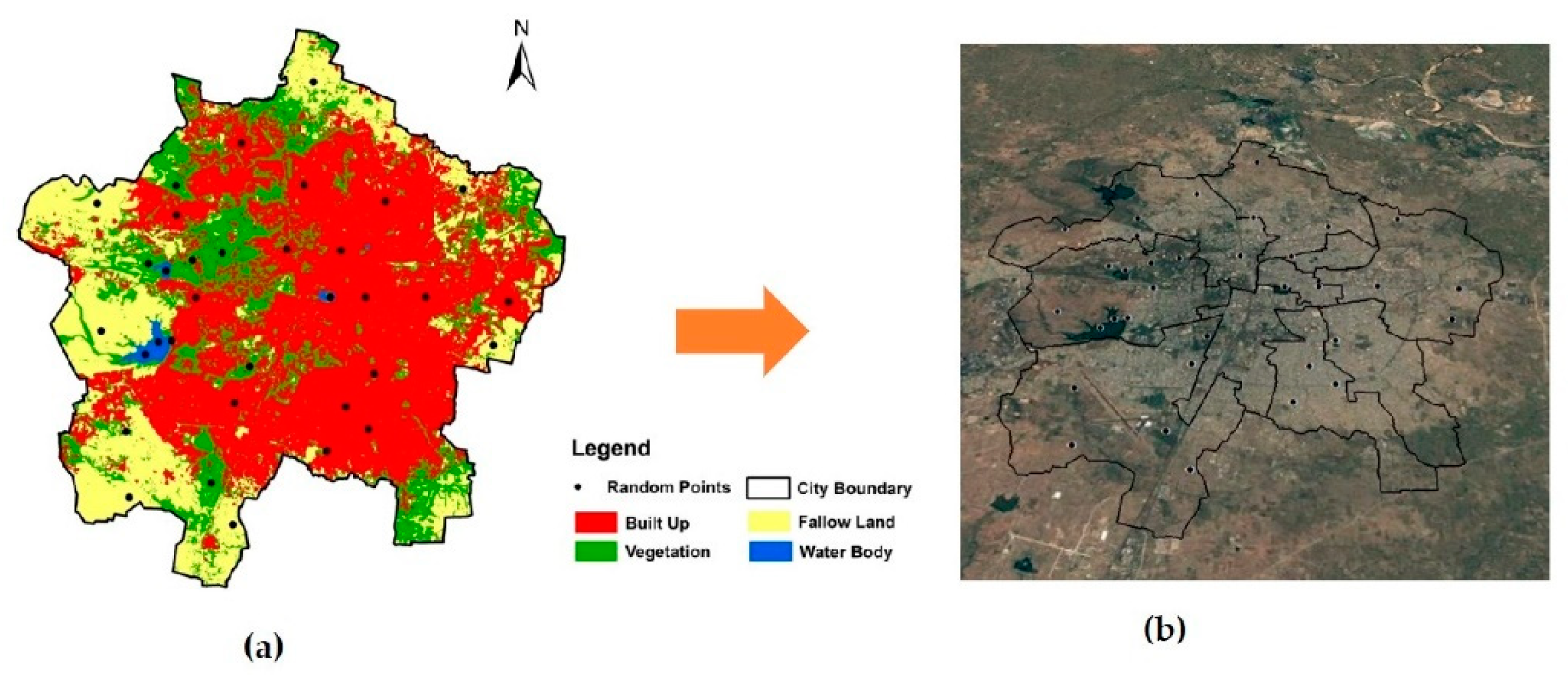
| LULC 2011 | Built-Up | Vegetation | Fallow Land | Water Bodies | Row Total | User’s Accuracy |
|---|---|---|---|---|---|---|
| Built-Up | 12 | 1 | 1 | 0 | 14 | 86 |
| Vegetation | 0 | 7 | 1 | 0 | 8 | 88 |
| Fallow Land | 0 | 0 | 7 | 0 | 7 | 100 |
| Water Bodies | 0 | 0 | 0 | 5 | 5 | 100 |
| Total | 12 | 8 | 9 | 5 | 34 | |
| Producer’s Accuracy | 100 | 88 | 78 | 100 | ||
| Overall Accuracy | 91 | |||||
| Kappa Coefficient | 85 | |||||
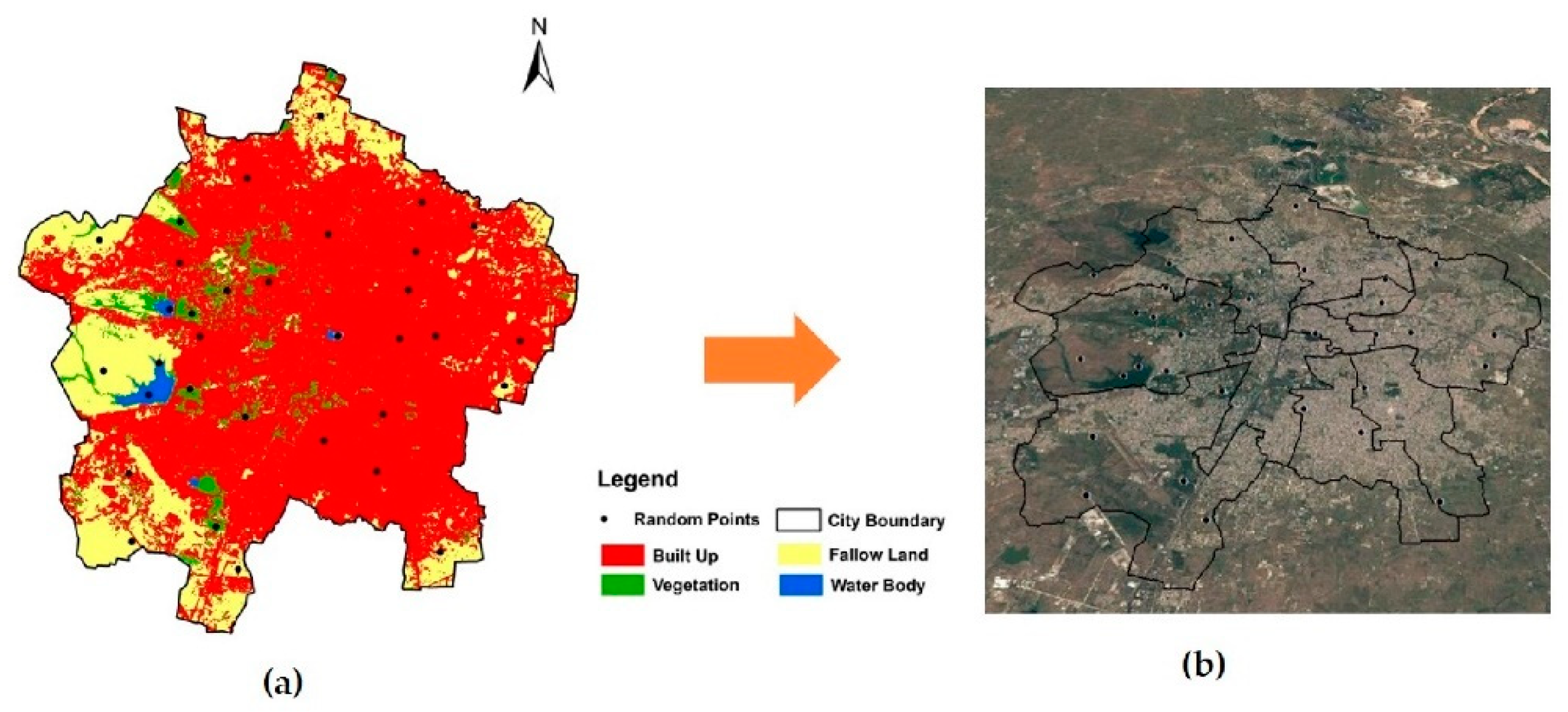
| LULC 2011 | Built-Up | Vegetation | Fallow Land | Water Bodies | Row Total | User’s Accuracy |
|---|---|---|---|---|---|---|
| Built-Up | 12 | 0 | 1 | 0 | 13 | 92 |
| Vegetation | 0 | 7 | 1 | 0 | 8 | 88 |
| Fallow Land | 1 | 0 | 6 | 0 | 7 | 100 |
| Water Bodies | 0 | 0 | 0 | 5 | 5 | 100 |
| Total | 13 | 7 | 8 | 5 | 33 | |
| Producer’s Accuracy | 92 | 100 | 75 | 100 | ||
| Overall Accuracy | 91 | |||||
| Kappa Coefficient | 86 | |||||
References
- Brushlinsky, N.N.; Ahrens, M.; Sokolov, S.V.; Wagner, P. World Fire Statistics, Centre of Fire Statistics 25. 2020. Available online: http://www.ctif.org/sites/default/files/ctif_report23_world_fire_statistics_2018.pdf (accessed on 11 September 2020).
- Pinkerton and FICCI, India Risk Survey 2019. Available online: https://ficci.in/Sedocument/20487/India-Risk-Survey-2019-ficci.pdf (accessed on 23 April 2019).
- National Crime Records Bureau 2019. Available online: https://ncrb.gov.in/en/crime-india-2019-0 (accessed on 23 August 2020).
- Rahardjo, H.A.; Prihanton, M. The most critical issues and challenges of fire safety for building sustainability in Jakarta. J. Build. Eng. 2020, 29, 101133. [Google Scholar] [CrossRef]
- Lee, Y.H.; Kim, M.S.; Lee, J.S. Firefighting in vulnerable areas based on the connection between fire hydrants and fire brigade. Sustainability 2021, 13, 98. [Google Scholar] [CrossRef]
- UNDESA. Department of Economics and Social Affairs. 2017. Available online: https://www.un.org/development/desa/en/news/population/2018-revision-of-world-urbanization-prospects.html (accessed on 11 May 2019).
- UN-Habitat. World Cities Report 2016, Urbanization and Development: Emerging Futures. Available online: www.unhabitat.org (accessed on 11 May 2019).
- Mckinsey. India’s Urban Awakening: Building Inclusive Cities, Sustaining Economic Growth. 2010. Available online: https://www.mckinsey.com//media/Mckinsey/GlobalThemes/Urbanization/UrbanawakeninginIndia/MGI_Indias_urban_awakening_executive_summary.ashx (accessed on 18 November 2018).
- Kantakumar, L.N.; Kumar, S.; Schneider, K. SUSM: A scenario-based urban growth simulation model using remote sensing data. Eur. J. Remote Sens. 2019, 52, 26–41. [Google Scholar] [CrossRef] [Green Version]
- Perez, J.; Fusco, G.; Moriconi-Ebrard, F. Identification and quantification of urban space in India: Defining urban macro-structures. Urban Stud. 2019, 56, 1988–2004. [Google Scholar] [CrossRef]
- Zhang, X.; Yao, J.; Sila-Nowicka, K.; Jin, Y. Urban fire dynamics and its association with urban growth: Evidence from Nanjing, China. ISPRS Int. J. Geo Inf. 2020, 9, 218. [Google Scholar] [CrossRef] [Green Version]
- Kiran, K.C.; Corcoran, J. Modelling residential fire incident response times: A spatial analytic approach. Appl. Geogr. 2017, 84, 64–74. [Google Scholar] [CrossRef]
- Yao, J.; Zhang, X. Location optimization of fire stations: Trade-off between accessibility and service coverage. In Proceedings of the 9th International Conference on GIScience Short Paper Proceedings, Montreal, QC, Canada, 27–30 September 2016. [Google Scholar] [CrossRef] [Green Version]
- Yao, J.; Zhang, X.; Murray, A.T. Location optimization of urban fire stations: Access and service coverage. Comput. Environ. Urban Syst. 2019, 73, 184–190. [Google Scholar] [CrossRef]
- Špatenková, O.; Virrantaus, K. Discovering Spatio-temporal relationships in the distribution of building fires. Fire Saf. J. 2013, 62, 49–63. [Google Scholar] [CrossRef]
- Masoumi, Z.; van L Genderen, J.; Maleki, J. Fire risk assessment in dense urban areas using information fusion techniques. ISPRS Int. J. Geo-Inf. 2019, 8, 579. [Google Scholar] [CrossRef] [Green Version]
- Raškauskaitė, R.; Grigonis, V. An Approach for the analysis of the accessibility of fire hydrants in urban territories. ISPRS Int. J. Geo-Inf. 2019, 8, 587. [Google Scholar] [CrossRef] [Green Version]
- Corcoran, J.; Higgs, G.; Brunsdon, C.; Ware, A.; Norman, P. The use of spatial analytical techniques to explore patterns of fire incidence: A South Wales case study. Comput. Environ. Urban Syst. 2007, 31, 623–647. [Google Scholar] [CrossRef]
- Gul Guldåker, N.; Hallin, P.O. Spatio-temporal patterns of intentional fires, social stress and socio-economic determinants: A case study of Malmö, Sweden. Fire Saf. J. 2014, 70, 71–80. [Google Scholar] [CrossRef] [Green Version]
- Corcoran, J.; Higgs, G.; Higginson, A. Fire incidence in metropolitan areas: A comparative study of Brisbane (Australia) and Cardiff (United Kingdom). Appl. Geogr. 2011, 31, 65–75. [Google Scholar] [CrossRef]
- Ardianto, R.; Chhetri, P. Modeling spatial-temporal dynamics of urban residential fire risk using a Markov chain technique. Int. J. Disaster Risk Sci. 2019, 10, 57–73. [Google Scholar] [CrossRef] [Green Version]
- Jennings, C.R. Socioeconomic characteristics and their relationship to fire incidence: A review of the literature. Fire Technol. 1999, 35, 7–34. [Google Scholar] [CrossRef]
- Wang, Z.; Zhang, X.; Xu, B. Spatio-temporal features of China’s urban fires: An investigation with reference to gross domestic product and humidity. Sustainability 2015, 7, 9734–9752. [Google Scholar] [CrossRef] [Green Version]
- Jennings, C.R. Social and economic characteristics as determinants of residential fire risk in urban neighborhoods: A review of the literature. Fire Saf. J. 2013, 62, 13–19. [Google Scholar] [CrossRef]
- Duncanson, M.; Woodward, A.; Reid, P. Socioeconomic deprivation and fatal unintentional domestic fire incidents in New Zealand 1993–1998. Fire Saf. J. 2002, 37, 165–179. [Google Scholar] [CrossRef]
- Chhetri, P.; Corcoran, J.; Stimson, R.J.; Inbakaran, R. Modelling potential Socio-economic determinants of building fires in southeast Queensland. Geogr. Res. 2010, 48, 75–85. [Google Scholar] [CrossRef]
- Wuschke, K.; Clare, J.; Garis, L. Temporal and geographic clustering of residential structure fires: A theoretical platform for targeted fire prevention. Fire Saf. J. 2013, 62, 3–12. [Google Scholar] [CrossRef]
- Corcoran, J.; Higgs, G.; Brunsdon, C.; Ware, A. The use of comaps to explore the spatial and temporal dynamics of fire incidents: A case study in South Wales, United Kingdom. Prof. Geogr. 2007, 59, 521–536. [Google Scholar] [CrossRef] [Green Version]
- LeBlanc, J.C.; Pless, I.B.; King, W.J.; Bawden, H.; Bernard-Bonnin, A.C.; Klassen, T.; Tenenbein, M. Home safety measures and the risk of unintentional injury among young children: A multicentre case-control study. CMAJ 2006, 175, 883–887. [Google Scholar] [CrossRef] [PubMed] [Green Version]
- Besag, J.; Newell, J. The detection of clusters in rare diseases. J. R. Stat. Soc. Ser. A Stat. Soc. 1991, 154, 143–155. [Google Scholar] [CrossRef]
- Schaefer, A.J.; Magi, B.I. Land-cover dependent relationships between fire and soil moisture. Fire 2019, 2, 55. [Google Scholar] [CrossRef] [Green Version]
- Sequeira, C.R.; Rego, F.C.; Montiel-Molina, C.; Morgan, P. Half-century changes in LULC and fire in two iberian inner mountain areas. Fire 2019, 2, 45. [Google Scholar] [CrossRef] [Green Version]
- Caggiano, M.D.; Hawbaker, T.J.; Gannon, B.M.; Hoffman, C.M. Building loss in WUI disasters: Evaluating the core components of the wildland–Urban interface definition. Fire 2020, 3, 73. [Google Scholar] [CrossRef]
- Dhyani, S.; Lahoti, S.; Khare, S.; Pujari, P.; Verma, P. Ecosystem based disaster risk reduction approaches (EbDRR) as a prerequisite for inclusive urban transformation of Nagpur City, India. Int. J. Disaster Risk Reduct. 2018, 32, 95–105. [Google Scholar] [CrossRef]
- Singh, P.P.; Sabnani, C.S.; Kapse, V.S. Integrating benchmark assessment of emergency fire service using geoinformation technology. Int. J. Disaster Risk Reduct. 2021, 63, 102432. [Google Scholar] [CrossRef]
- Asgary, A.; Ghaffari, A.; Levy, J. Spatial and temporal analyses of structural fire incidents and their causes: A case of Toronto, Canada. Fire Saf. J. 2010, 45, 44–57. [Google Scholar] [CrossRef]
- Han, A.; Qing, S.; Bao, Y.; Na, L.; Bao, Y.; Liu, X.; Zhang, J.; Wang, C. Short-term effects of fire severity on vegetation based on sentinel-2 satellite data. Sustainability 2021, 13, 432. [Google Scholar] [CrossRef]
- Lin, Y.S. Estimations of the probability of fire occurrences in buildings. Fire Saf. J. 2005, 40, 728–735. [Google Scholar] [CrossRef]
- Hanea, D.; Ale, B. Risk of human fatality in building fires: A decision tool using Bayesian networks. Fire Saf. J. 2009, 44, 704–710. [Google Scholar] [CrossRef]
- Wu, J.; Hu, Z.; Chen, J.; Li, Z. Risk assessment of underground subway stations to fire disasters using Bayesian network. Sustainability 2018, 10, 3810. [Google Scholar] [CrossRef] [Green Version]
- ArcGIS Desktop. Arcmap 10.3; An overview of the Mapping Clusters toolset. Available online: https://desktop.arcgis.com/en/arcmap/10.3/tools/spatial-statistics-toolbox/an-overview-of-the-mapping-clusters-toolset.htm (accessed on 11 March 2020).
- Majumder, R.; Bhunia, G.S.; Patra, P.; Mandal, A.C.; Ghosh, D.; Shit, P.K. Assessment of flood hotspot at a village level using GIS-based spatial statistical techniques. Arab. J. Geosci. 2019, 12, 1–12. [Google Scholar] [CrossRef]
- ZahranEl-Said, M.M.; Jiann, T.S.; Mohamad’Asri, N.A.A.B.; Tan, E.H.A.; Yap, Y.H.; Rahman, E.K.A. Evaluation of various GIS-based methods for the analysis of road traffic accident hotspot. In MATEC Web of Conferences; EDP Sciences: Les Ulis, France, 2019; Volume 258, p. 03008. [Google Scholar] [CrossRef] [Green Version]
- Andersen, M.A.; Wuschke, K.; Kinney, J.B.; Brantingham, P.; Brantingham, P.J. Cartograms, crime and location quotients. Crime Patterns Anal. 2009, 2, 31–46. [Google Scholar]
- Constitution of India. Twelth Schedule-Arcticle 243 W. 1950. Available online: https://www.constitutionofindia.net/constitution_of_india/article_243w/articles (accessed on 14 August 2020).
- Atal Mission for Rejuvenation and Urban Transformation. Mission Statement and Guidelines, Ministry of Urban Development, Government of India. Available online: http://amrut.gov.in/upload/uploadfiles/files/AMRUT%20Guidelines%20(1).pdf (accessed on 25 January 2019).
- Pradhan Mantri Awas Yojna, Housing for All (Urban), Scheme Guidelines, Ministry of Housing and Urban Poverty Alleviation, Government of India, 2015. Available online: https://pmaymis.gov.in/PDF/HFA_Guidelines/hfa_Guidelines.pdf. (accessed on 27 January 2019).
- Heritage City Development & Augmentation Yojna. Ministry of Urban Development, Government of India. Available online: http://mohua.gov.in/upload/uploadfiles/files/Guidelines%20HRIDAY.pdf (accessed on 25 January 2019).
- National Disaster Management Authority, Government of India. Available online: https://ndma.gov.in/Response/Fire-Service (accessed on 16 September 2019).
- Kiran, K.C.; Corcoran, J.; Chhetri, P. Measuring the spatial accessibility to fire stations using enhanced floating catchment method. Socio Econ. Plan. Sci. 2020, 69, 100673. [Google Scholar] [CrossRef]
- Smart City Mission. Transform-nation, Mission Statement and Guidelines, Ministry of Urban Development, Government of India. 2015. Available online: https://smartcities.gov.in (accessed on 11 September 2019).
- Sustainable Development Goals, SDG-11. Available online: https://www.un.org/sustainabledevelopment/cities/ (accessed on 22 September 2019).
- Census of India. Census Digital Library. Registrar General & Census Commissioner, India, Ministry of Home affairs, Government of India. 2011. Available online: https://www.censusindia.gov.in/2011-Common/CensusData2011.html (accessed on 22 September 2018).
- India Meteorological Department (IMD); Ministry of Earth Sciences; Climate Application and User Interface; Climatology of Smart Cities, Climate Smart City-Nagpur (Sonegaon). Available online: https://imdpune.gov.in/caui/smartcities.html (accessed on 23 March 2021).
- Nagpur Municipal Corporation. Available online: https://www.nmcnagpur.gov.in/assets/250/2018/10/.../Final_CDP_Nagpur_Mar_15.pdf (accessed on 11 August 2019).
- Zhang, X.; Yao, J.; Sila-Nowicka, K. Exploring spatiotemporal dynamics of urban fires: A case of Nanjing, China. ISPRS Int. J. Geo Inf. 2018, 7, 7. [Google Scholar] [CrossRef] [Green Version]
- World Urbanization Prospects 2018-United Nations Population Estimates and Projections of Major Urban Agglomerations. Available online: https://worldpopulationreview.com/world-cities/nagpur-population. (accessed on 22 March 2019).
- National Building Code of India (NBCI) 2016, Bureau of Indian Standards, The National Standards Body of India; Government of India: New Delhi, India, 2016.
- Hart, T.; Zandbergen, P. Kernel density estimation and hotspot mapping. Polic. Int. J. Police Strategy Manag. 2014, 37, 305–323. [Google Scholar] [CrossRef]
- Barbosa, M.L.F.; Delgado, R.C.; Teodoro, P.E.; Pereira, M.G.; Correia, T.P.; de Mendonça, B.A.F.; de Ávila Rodrigues, R. Occurrence of fire foci under different land uses in the State of Amazonas during the 2005 drought. Environ. Dev. Sustain. 2019, 21, 2707–2720. [Google Scholar] [CrossRef]
- Colak, H.E.; Memisoglu, T.; Erbas, Y.S.; Bediroglu, S. Hot spot analysis based on network spatial weights to determine spatial statistics of traffic accidents in Rize, Turkey. Arab. J. Geosci. 2018, 11, 1–11. [Google Scholar] [CrossRef]
- ESRI. Available online: https://desktop.arcgis.com/en/arcmap/10.3/tools/3d-analyst-toolbox/how-idw-works.htm#:~:text=Inverse%20distance%20weighted%20(IDW)%20interpolation,of%20a%20locationally%20dependent%20variable (accessed on 30 April 2021).
- Silverman, B.W. Density Estimation for Statistics and Data Analysis; Routledge: London, UK, 2018. [Google Scholar] [CrossRef]
- Ord, J.K.; Getis, A. Local spatial autocorrelation statistics: Distributional issues and an application. Geogr. Anal. 1995, 27, 286–306. [Google Scholar] [CrossRef]
- Srikanth, L.; Srikanth, I. A case study on kernel density estimation and hotspot analysis methods in traffic safety management. In Proceedings of the 2020 International Conference on COMmunication Systems & NETworkS (COMSNETS), IEEE, Bangalore, India, 7–11 January 2020; pp. 99–104. [Google Scholar] [CrossRef]
- Lippi, C.A.; Stewart-Ibarra, A.M.; Romero, M.; Lowe, R.; Mahon, R.; Van Meerbeeck, C.J.; Rollock, L.; Hilaire, M.G.S.; Trotman, A.R.; Holligan, D.; et al. Spatiotemporal tools for emerging and endemic disease hotspots in small areas: An analysis of dengue and chikungunya in Barbados, 2013–2016. Am. J. Trop. Med. Hyg. 2020, 103, 149–156. [Google Scholar] [CrossRef]
- Smith, M.; Goodchild, M.F.; Longley, P.A. Geoespatial Analisys. A Comprehensive Guide to Principles Techniques and Software Tools. Available online: https://www.spatialanalysisonline.com/extractv6.pdf (accessed on 12 May 2021).
- ESRI. How Hotspot Analysis (Getis-Ord Gi*) Works. Available online: https://pro.arcgis.com/en/pro-app/latest/tool-reference/spatial-statistics/h-how-hot-spot-analysis-getis-ord-gi-spatial-stati.htm (accessed on 11 February 2020).
- Simpson, S. Resource allocation by measures of relative social need in geographical areas: The relevance of the signed χ2, the percentage, and the raw count. Environ. Plan. A 1996, 28, 537–554. [Google Scholar] [CrossRef]
- Prasannakumar, V.; Vijith, H.; Charutha, R.; Geetha, N. Spatio-temporal clustering of road accidents: GIS-based analysis and assessment. Procedia Soc. Behav. Sci. 2011, 21, 317–325. [Google Scholar] [CrossRef] [Green Version]
- Montiel-Molina, C.; Vilar, L.; Romão-Sequeira, C.; Karlsson, O.; Galiana-Martín, L.; Madrazo-García de Lomana, G.; Palacios-Estremera, M.T. Have historical land use/land cover changes triggered a fire regime shift in central Spain? Fire 2019, 2, 44. [Google Scholar] [CrossRef] [Green Version]
- Chettry, V.; Surawar, M. Assessment of urban sprawl characteristics in Indian cities using remote sensing: Case studies of Patna, Ranchi, and Srinagar. Environ. Dev. Sustain. 2021, 23, 11913–11935. [Google Scholar] [CrossRef]
- Patel, N.; Mukherjee, R. Extraction of impervious features from spectral indices using artificial neural network. Arab. J. Geosci. 2015, 8, 3729–3741. [Google Scholar] [CrossRef]
- Minta, M.; Kibret, K.; Thorne, P.; Nigussie, T.; Nigatu, L. Land use and land cover dynamics in Dendi-Jeldu hilly-mountainous areas in the central Ethiopian highlands. Geoderma 2018, 314, 27–36. [Google Scholar] [CrossRef]
- Korhonen, P.; Moskowitz, H.; Wallenius, J. Multiple criteria decision support-A review. Eur. J. Oper. Res. 1992, 63, 361–375. [Google Scholar] [CrossRef]
- Krackhardt, D. Predicting with networks: Nonparametric multiple regression analysis of dyadic data. Soc. Netw. 1988, 10, 359–381. [Google Scholar] [CrossRef]
- White, K.J. The Durbin-Watson test for autocorrelation in nonlinear models. Rev. Econ. Stat. 1992, 370–373. [Google Scholar] [CrossRef]
- Lee, J.H.; Chun, W.Y.; Choi, J.H. Weighting the attributes of human-related activities for fire safety measures in historic villages. Sustainability 2021, 13, 3236. [Google Scholar] [CrossRef]
- Ricotta, C.; Bajocco, S.; Guglietta, D.; Conedera, M. Assessing the influence of roads on fire ignition: Does land cover matter? Fire 2018, 1, 24. [Google Scholar] [CrossRef] [Green Version]
- Nyimbili, P.H.; Erden, T. A hybrid approach integrating entropy-AHP and GIS for suitability assessment of urban emergency facilities. ISPRS Int. J. Geo Inf. 2020, 9, 419. [Google Scholar] [CrossRef]
- Vani, M.; Prasad, P.R.C. Assessment of spatio-temporal changes in land use and land cover, urban sprawl, and land surface temperature in and around Vijayawada city, India. Environ. Dev. Sustain. 2020, 22, 3079–3095. [Google Scholar] [CrossRef]
- Syphard, A.D.; Rustigian-Romsos, H.; Keeley, J.E. Multiple-scale relationships between vegetation, the wildland–urban interface, and structure loss to wildfire in California. Fire 2021, 4, 12. [Google Scholar] [CrossRef]
- Ebenehi, I.Y.; Mohamed, S.; Sarpin, N.; Masrom, M.A.N.; Zainal, R.; Azmi, M.M. The management of building fire safety towards the sustainability of Malaysian public universities. In Proceedings of the IOP Conference Series: Materials Science and Engineering, Birmingham, UK, 13–15 October 2017; Volume 271, p. 012034. [Google Scholar] [CrossRef]
- The Smart City Challenge, Stage 2, Smart City Proposal, Nagpur. Available online: http://smartcities.gov.in/upload/uploadfiles/files/Nagpur_SCP.pdf (accessed on 25 January 2020).
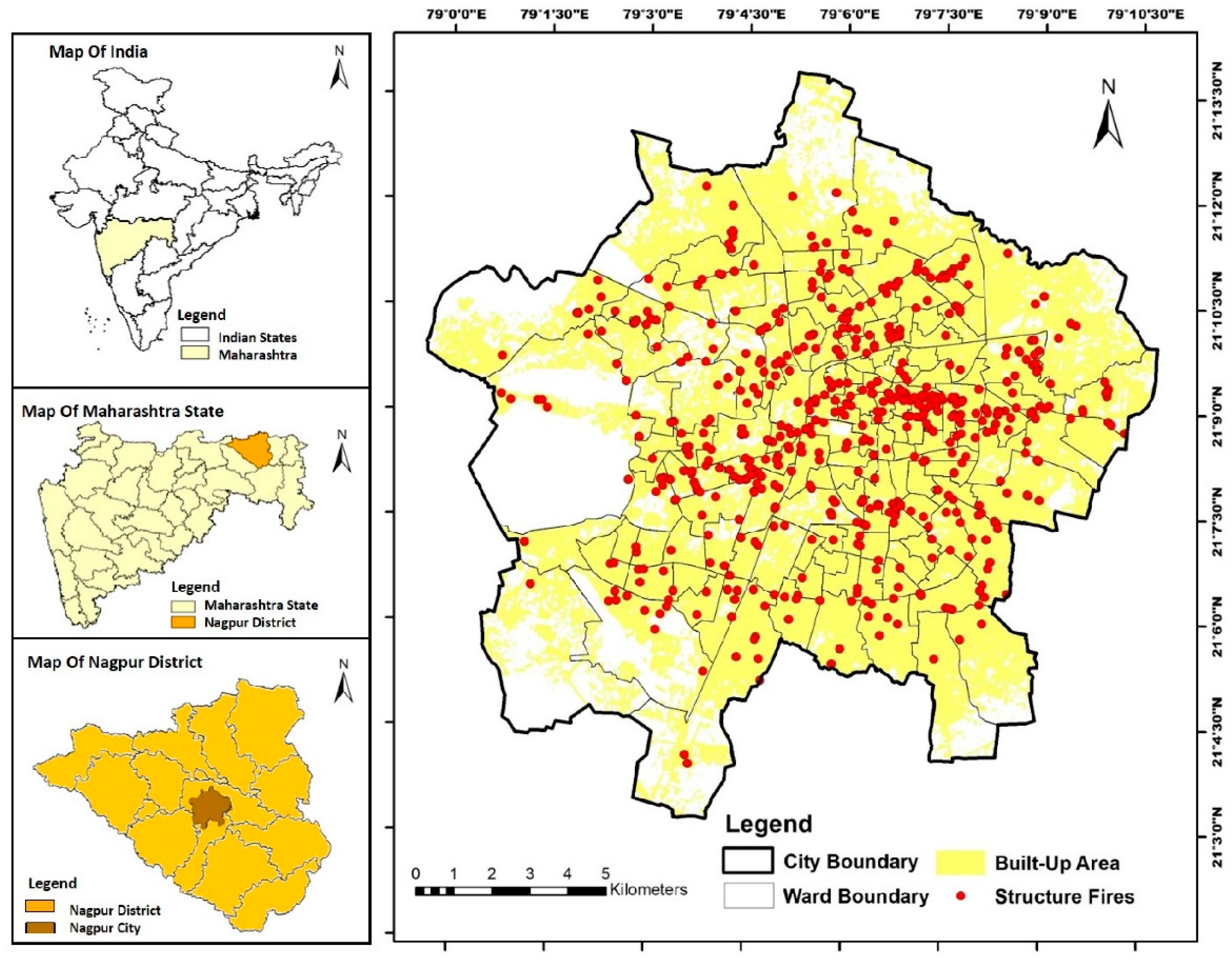
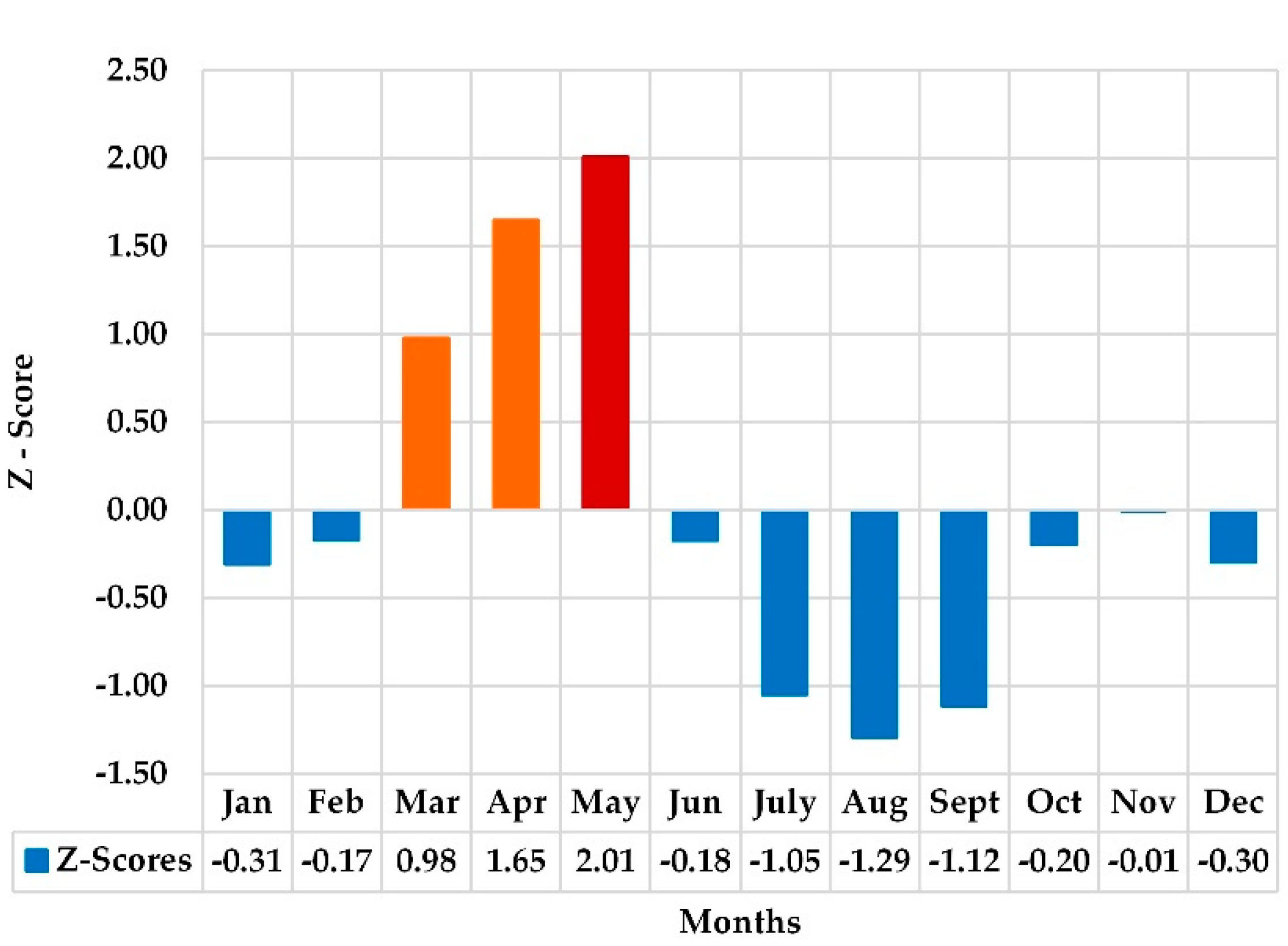
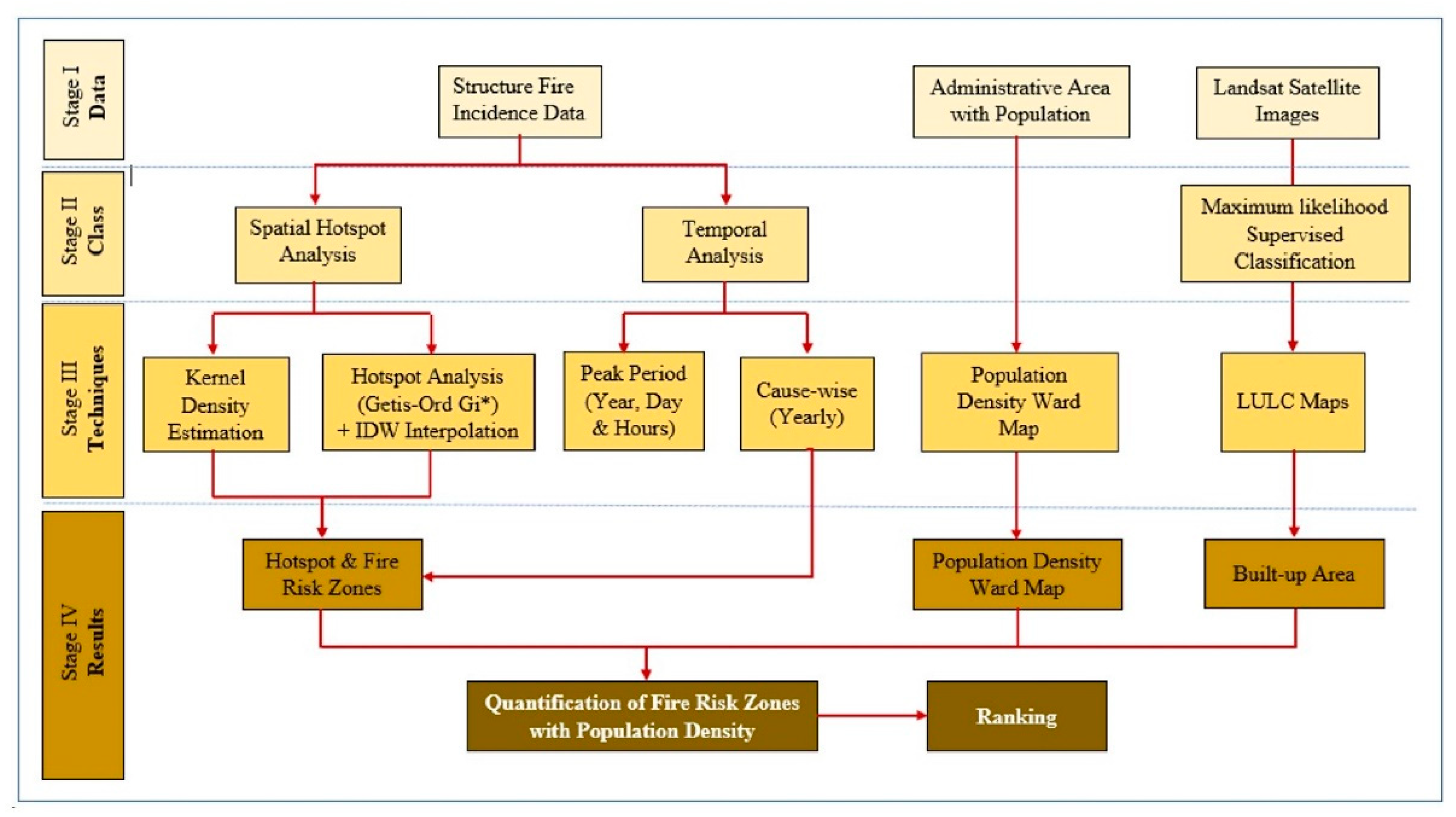
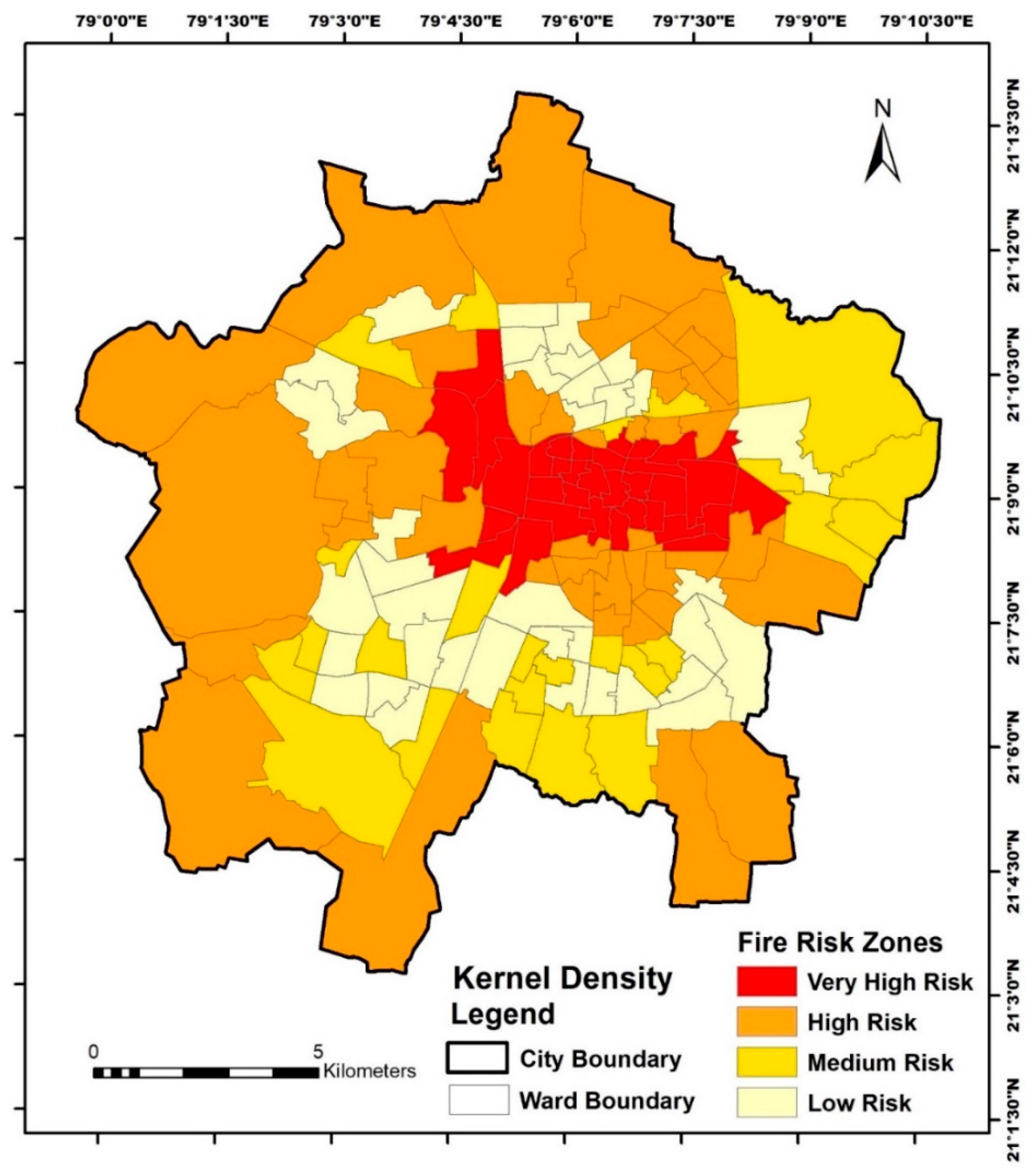

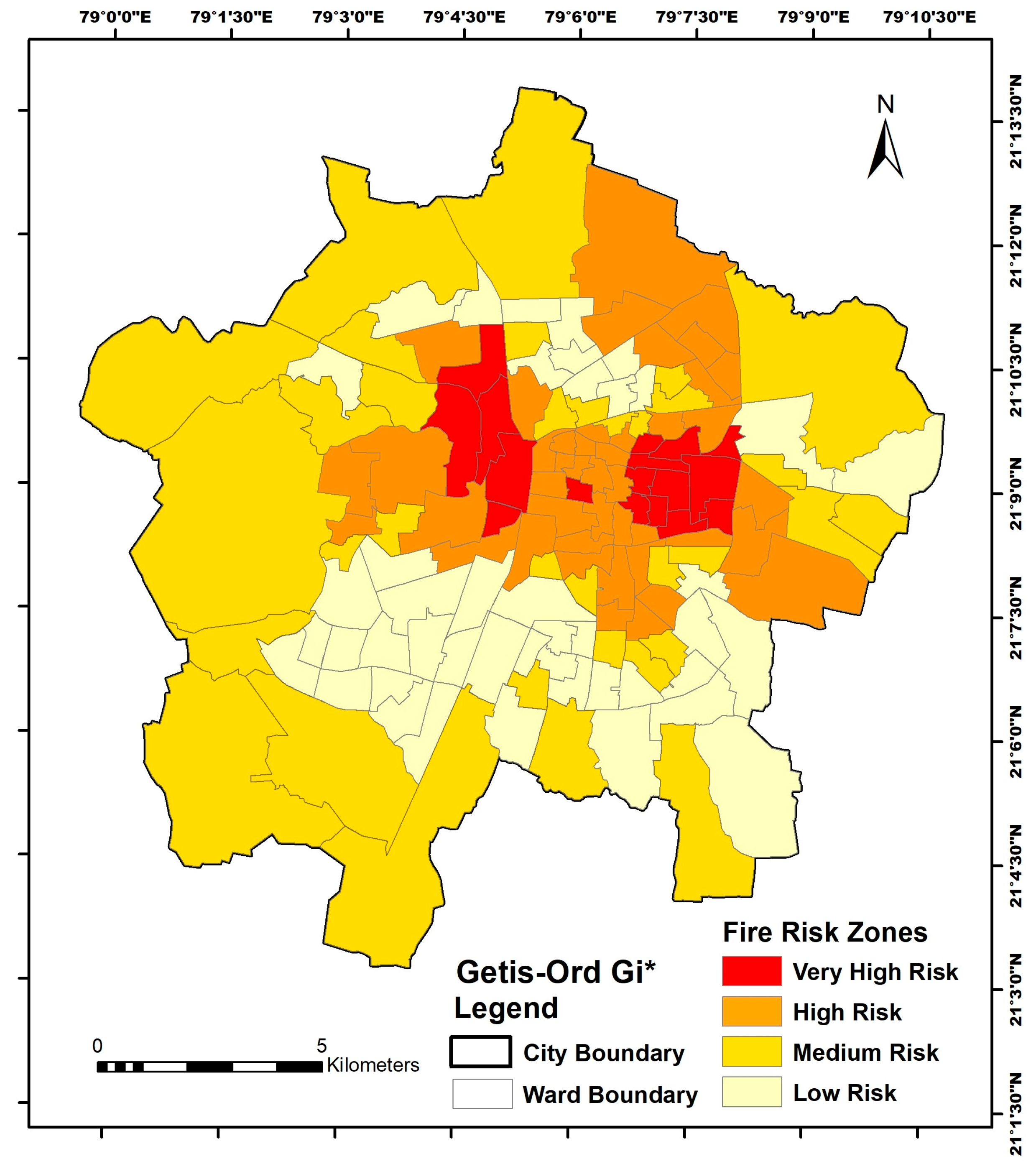
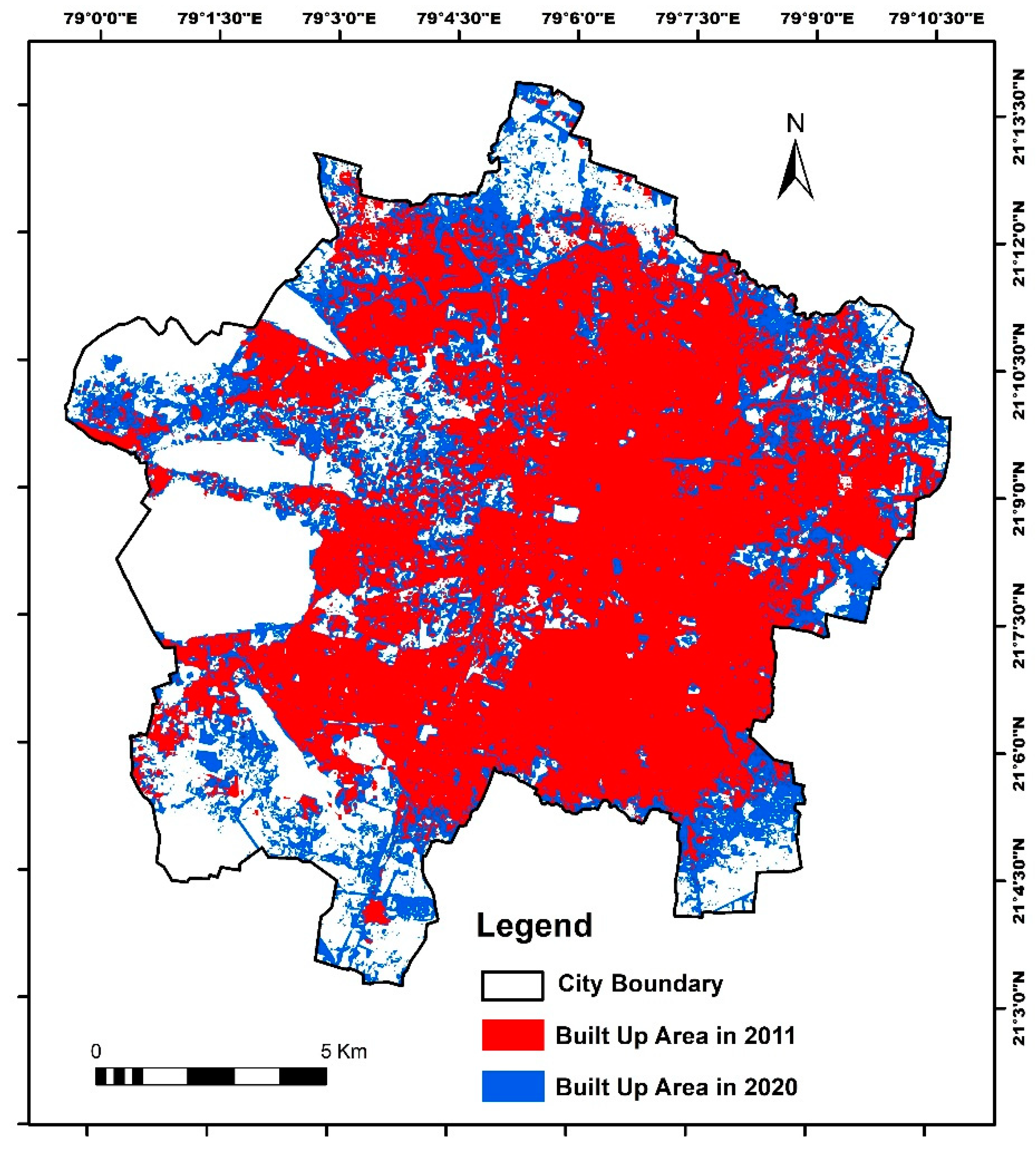
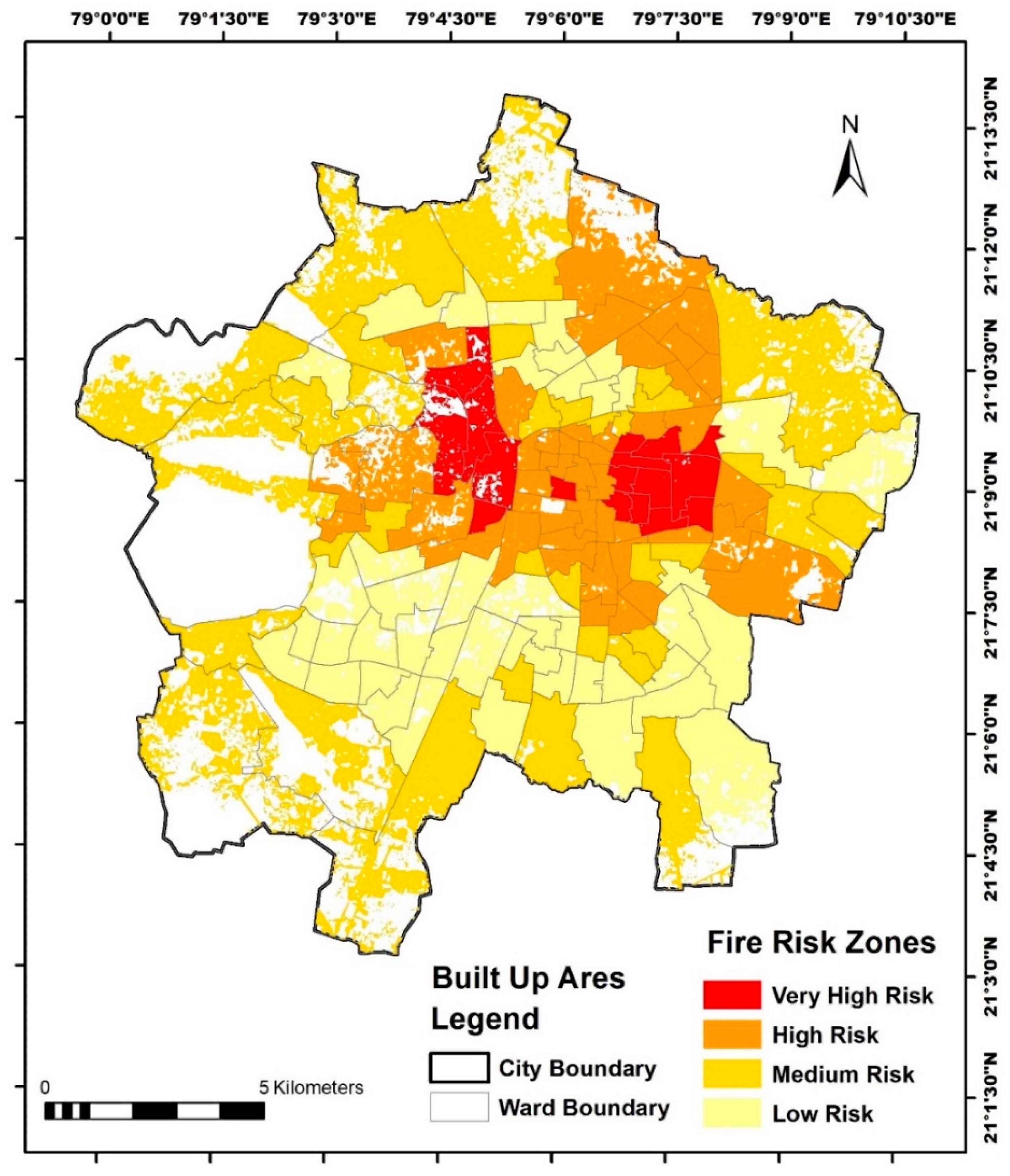
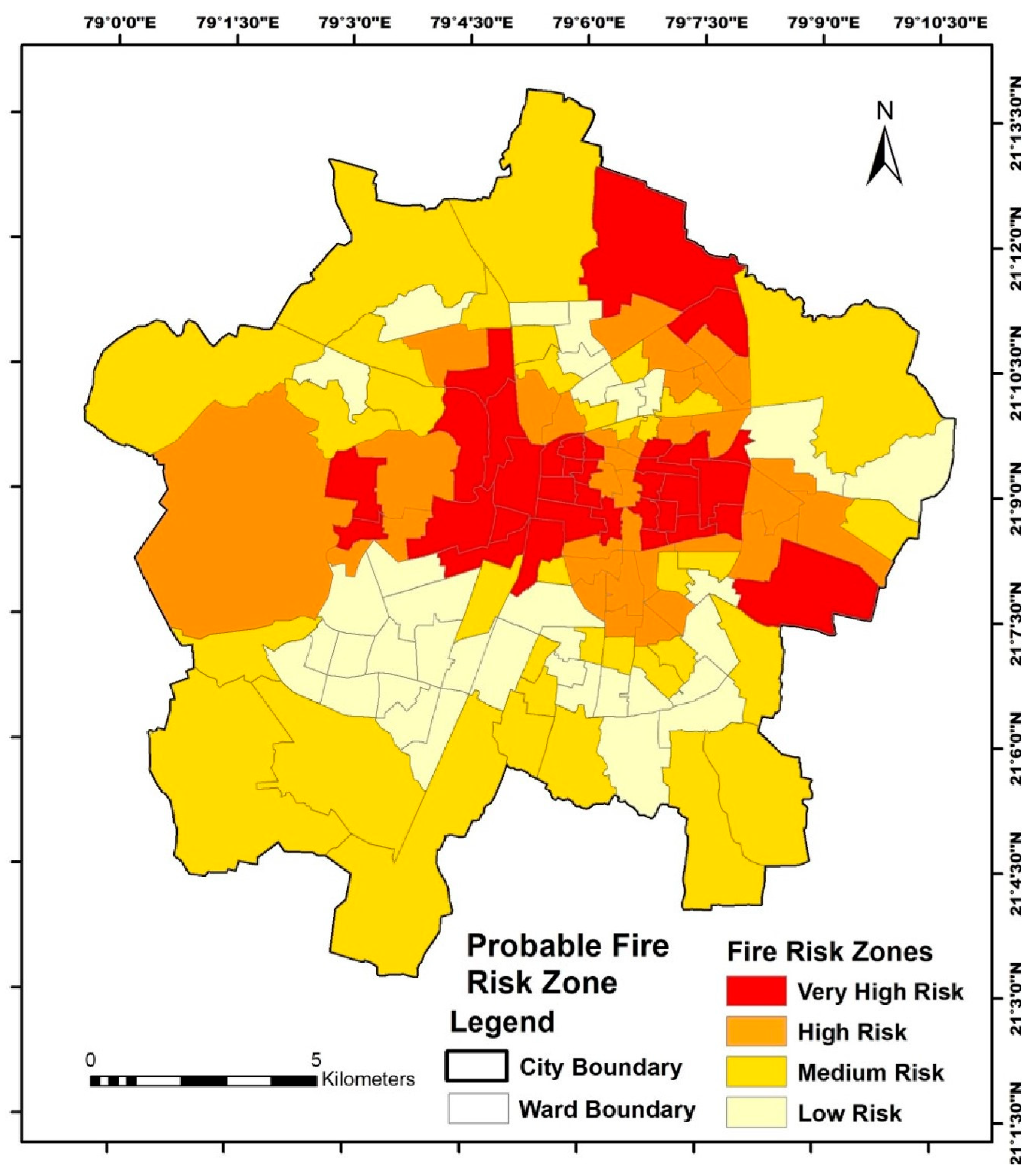

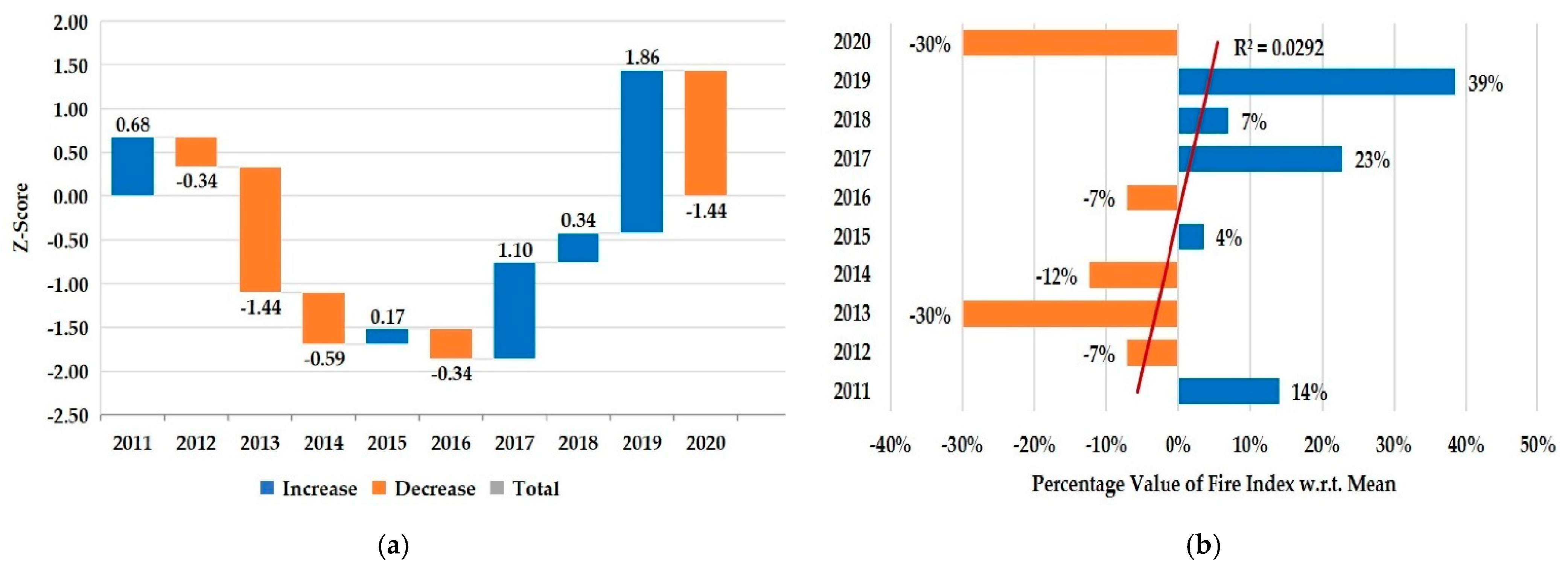
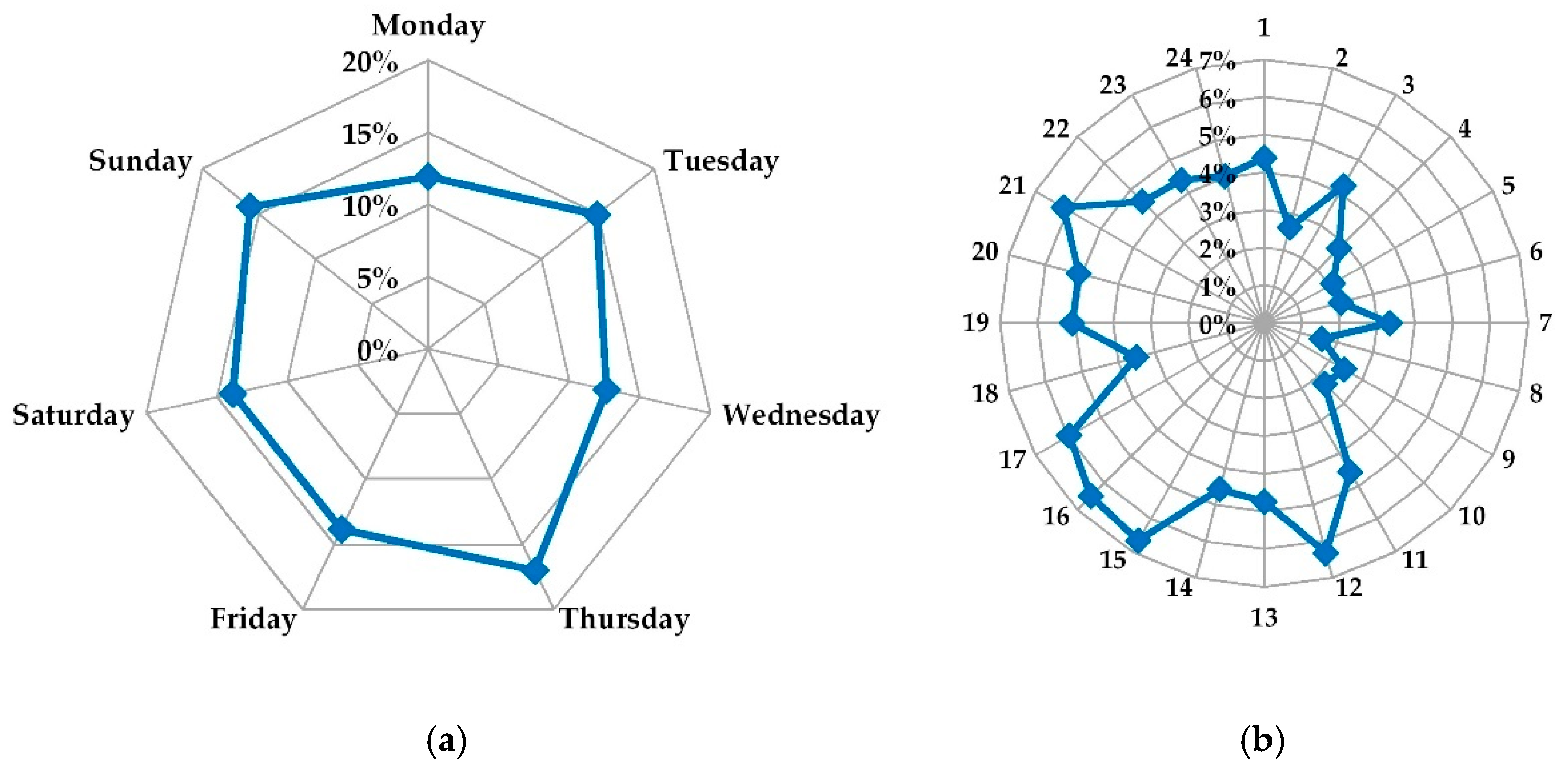

| Landsat Satellite | Sensor | Scene ID | Path/Row | Acquisition Date |
|---|---|---|---|---|
| Landsat-5 | TM | LT51440452011162KHC04 | 144/45 | 11 June 2011 |
| Landsat-8 | OLI_TIRS | LC81440452020139LGN00 | 144/45 | 18 May 2020 |
| Geometric Interval Values | Fire Risk Zones | Number of Wards | Percentage Area | Percentage Population | Population Density per km2 | Ranking Based on Population Density |
|---|---|---|---|---|---|---|
| 3.43–24.48 | Very High | 34 | 9 | 20 | 29,860 | 1 |
| −0.50–3.42 | High | 43 | 54 | 33 | 8339 | 4 |
| −1.23–−0.51 | Medium | 25 | 21 | 22 | 14,268 | 3 |
| −5.17–−1.24 | Low | 36 | 17 | 26 | 21,078 | 2 |
| Z-Score | Type | Number of Wards | Percentage Area | Percentage Population | Population Density per km2 | Ranking Based on Population Density |
|---|---|---|---|---|---|---|
| >1.96 | Very High | 17 | 5 | 10 | 25,526 | 1 |
| 1.96 to 0.65 | High | 43 | 19 | 28 | 20,313 | 2 |
| 0.65 to −0.65 | Medium | 34 | 52 | 29 | 7655 | 4 |
| −0.65 to −1.96 | Low | 44 | 24 | 33 | 18,857 | 3 |
| Z-Score | Type | Actual Built-Up Area Percentage | Built-Up Density Percentage | Population Density per km2 of Built-Up Area | Ranking Based on Population Density |
|---|---|---|---|---|---|
| >1.96 | Very High | 7 | 91 | 27,994 | 1 |
| 1.96 to 0.65 | High | 22 | 86 | 23,659 | 2 |
| 0.65 to −0.65 | Medium | 42 | 60 | 12,750 | 4 |
| −0.65 to −1.96 | Low | 29 | 90 | 20,904 | 3 |
| Total | 73 | 18,508 | |||
| Occupancy Type | Very High | High | Medium | Low |
|---|---|---|---|---|
| Residential | 35 | 43 | 59 | 53 |
| Educational | 1 | 1 | 3 | 2 |
| Institutional | 0 | 1 | 1 | 3 |
| Assembly | 0 | 3 | 3 | 5 |
| Business | 8 | 5 | 3 | 3 |
| Mercantile | 39 | 34 | 30 | 27 |
| Industrial | 12 | 11 | 1 | 3 |
| Storage | 5 | 2 | 1 | 3 |
| Z-Score | Type | Number of Wards | Percentage Area | Percentage Population 2031 | Population Density for 2031 per km2 | Ranking Based on Population Density |
|---|---|---|---|---|---|---|
| >1.96 | Very High | 34 | 15 | 21 | 22,350 | 1 |
| 1.96 to 0.65 | High | 34 | 20 | 22 | 18,258 | 3 |
| 0.65 to −0.65 | Medium | 35 | 47 | 30 | 10,138 | 4 |
| −0.65 to −1.96 | Low | 35 | 18 | 26 | 23,726 | 2 |
| Year | Fire Incidence Matrices | Population Matrices | Ratio | ||||
|---|---|---|---|---|---|---|---|
| Fire Index | Z-Score | Probability | PopulationIndex | Z-Score | Probability | ||
| 2011 | 1.14 | 0.68 | 0.75 | 0.93 | −1.54 | 0.06 | 2.59 |
| 2012 | 0.93 | −0.34 | 0.37 | 0.95 | −1.21 | 0.11 | 2.08 |
| 2013 | 0.70 | −1.44 | 0.08 | 0.96 | −0.88 | 0.19 | 1.54 |
| 2014 | 0.88 | −0.59 | 0.28 | 0.98 | −0.54 | 0.29 | 1.90 |
| 2015 | 1.04 | 0.17 | 0.57 | 0.99 | −0.19 | 0.42 | 2.20 |
| 2016 | 0.93 | −0.34 | 0.37 | 1.01 | 0.16 | 0.56 | 1.95 |
| 2017 | 1.23 | 1.10 | 0.86 | 1.02 | 0.52 | 0.70 | 2.53 |
| 2018 | 1.07 | 0.34 | 0.63 | 1.04 | 0.88 | 0.81 | 2.17 |
| 2019 | 1.39 | 1.86 | 0.97 | 1.06 | 1.22 | 0.89 | 2.77 |
| 2020 | 0.70 | −1.44 | 0.08 | 1.07 | 1.58 | 0.94 | 1.38 |
| Type | Gas Cylinder Leakage | Electric Short Circuit | Garbage Fire | Unknown | Other |
|---|---|---|---|---|---|
| Very High | 13 | 33 | 2 | 41 | 11 |
| High | 10 | 30 | 2 | 54 | 3 |
| Medium | 16 | 28 | 2 | 51 | 4 |
| Low | 17 | 31 | 2 | 42 | 8 |
| Total | 14 | 31 | 2 | 48 | 6 |
Publisher’s Note: MDPI stays neutral with regard to jurisdictional claims in published maps and institutional affiliations. |
© 2021 by the authors. Licensee MDPI, Basel, Switzerland. This article is an open access article distributed under the terms and conditions of the Creative Commons Attribution (CC BY) license (https://creativecommons.org/licenses/by/4.0/).
Share and Cite
Singh, P.P.; Sabnani, C.S.; Kapse, V.S. Hotspot Analysis of Structure Fires in Urban Agglomeration: A Case of Nagpur City, India. Fire 2021, 4, 38. https://0-doi-org.brum.beds.ac.uk/10.3390/fire4030038
Singh PP, Sabnani CS, Kapse VS. Hotspot Analysis of Structure Fires in Urban Agglomeration: A Case of Nagpur City, India. Fire. 2021; 4(3):38. https://0-doi-org.brum.beds.ac.uk/10.3390/fire4030038
Chicago/Turabian StyleSingh, Priya P., Chandra S. Sabnani, and Vijay S. Kapse. 2021. "Hotspot Analysis of Structure Fires in Urban Agglomeration: A Case of Nagpur City, India" Fire 4, no. 3: 38. https://0-doi-org.brum.beds.ac.uk/10.3390/fire4030038






